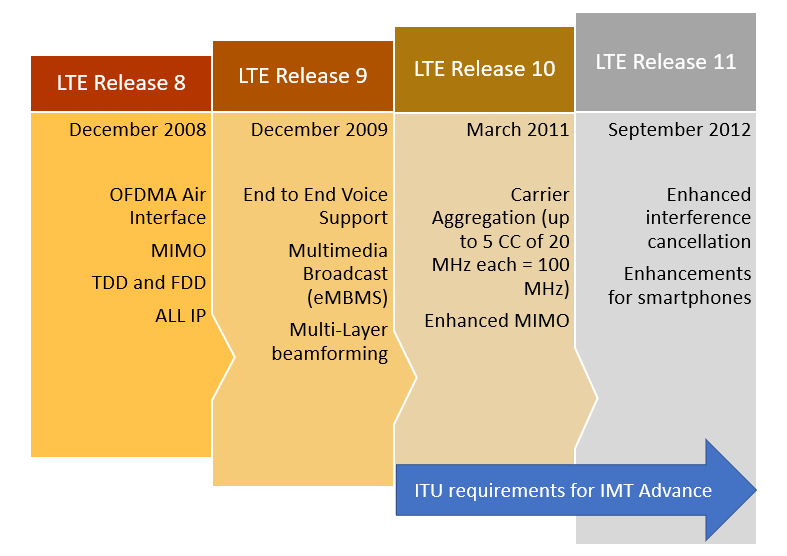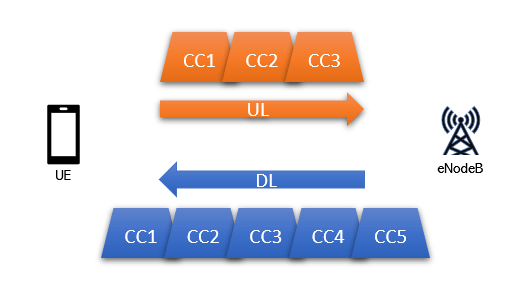To “G” or not to “G”, that is the question. Is LTE 4G? The answer is: depending on the LTE release you are talking about. In this post I’ll take a look at different LTE Releases and the criteria that the ITU uses to define a fourth generation (4G) mobile telecommunications system.
IMT-2000 and IMT-Advanced
ITU (International Telecommunication Union) uses the term IMT-Advanced in mobile systems whose capabilities go beyond IMT-2000. The third generation of wireless mobile telecommunications (3G) comply with the International Mobile Telecommunications-2000 (IMT-2000). The fourth generation of wireless mobile communication (4G) has to comply with IMT-Advanced.
At this point you may wonder what the requirements to comply with IMT-Advanced are. The list is bigger than the one I’m presenting here (refer to 3GPP TR36.913 for more information), but these are the key requirements:
- Based in an all-IP packet switched network
- Interoperability with existing wireless standards.
- A nominal data rate of 100 Mbit/s while the client physically moves at high speeds relative to the station, and 1 Gbit/s while the client and station are in relatively fixed positions.
- Peak link spectral efficiency of 15 bit/s/Hz in the downlink and 6.75 bit/s/Hz in the uplink
- Seamless connectivity and global roaming across multiple networks
The early releases of LTE comply with most of the requirements of IMT-Advance but they fall short in the nominal data rate and the spectral efficiency:

LTE release 8 and 9, despite great advance in performance from previous systems cannot be considered 4G. Still it all changed in released 10. At release 10, two main features appear: Carrier Aggregation and enhanced MIMO that made the improvements needed in throughput and spectral efficiency to comply and exceed IMT-Advance. By the way from Release 10 and beyond LTE is called LTE-Advanced.
Carrier Aggregation
Carrier Aggregation allows to add more carriers (component carriers) to increase bandwidth. It can be added up to 5 component carriers of 20 MHz in the downlink for a total bandwidth of 100 MHz. These component carriers can be of different bandwidth and allocated in the same frequency, contiguous or separated or even in different frequencies, which gives flexibility to implement and efficiency of use.

Enhanced MIMO
Enhanced MIMO allows two operation methods: single user (SU-MIMO) and multiple user (MU-MIMO) in downlink and uplink. A new transmission mode (TM9) was defined for enhanced MIMO. In downlink is possible to transmit up to 8×8 MIMO, while in uplink up to 4×4 MIMO.

But is not all – The throughput box
As I mentioned before most of these developments in LTE were to get higher throughput. Trinh Van Chien and Emil Björnson have defined an equation for an area throughput, but as there are 3 dimensions I consider it more of a “box of throughput”. The equation looks like this:
Area throughput (bit/s/km2) = Bandwidth (Hz) × Cell density (cells/km2) × Spectral efficiency (bit/s/Hz/cell)
Is possible to see here all the factors that contributes to a higher throughput. In case of release 10 and beyond, carrier aggregation contributes to a bigger bandwidth, while MIMO does the same for spectral efficiency. But what about Cell density? Since release 10 there were features introduced such as heterogeneous networks (which is a mix of macro and femto eNodesB) to tackle cell density. And in march 2015 LTE Release 12 was published including the Small cells and Network densification feature and the support for 256-QAM modulation.
Conclusions
The company I’m working for has a network that supports LTE release 12 features and utilizes most of them. Is it an LTE advance network? Well… it supports the features but it hardly meet IMT-Advance requirements. To be honest is the same with the other LTE networks I know. Seems that just support the LTE release allows the operators to naturally call their LTE network 4.5G. So, what is your experience?
Cheers!
Diego Goncalves Kovadloff
References:
Werner Mohr (2002). “Mobile Communications Beyond 3G in the Global Context” (PDF). Siemens mobile. Retrieved 26 March 2007.
Trinh Van Chien and Emil Björnson (2017). “Massive MIMO Communications” (PDF) part of “5G Mobile Communications”, Ed. Wei Xiang, Kan Zheng, Xuemin (Sherman) Shen


good work Diego, wish you all the success
LikeLike
Thanks a lot Wael!
LikeLike